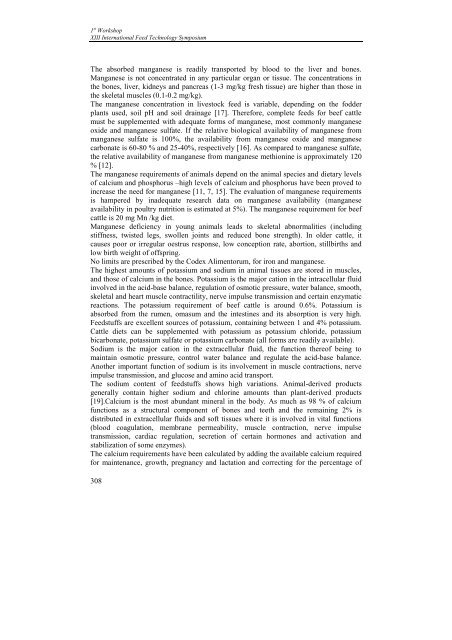Effects of dietary n-3 polyunsaturated fatty acids and ... - FINS
Effects of dietary n-3 polyunsaturated fatty acids and ... - FINS
Effects of dietary n-3 polyunsaturated fatty acids and ... - FINS
Create successful ePaper yourself
Turn your PDF publications into a flip-book with our unique Google optimized e-Paper software.
1 st WorkshopXIII International Feed Technology SymposiumThe absorbed manganese is readily transported by blood to the liver <strong>and</strong> bones.Manganese is not concentrated in any particular organ or tissue. The concentrations inthe bones, liver, kidneys <strong>and</strong> pancreas (1-3 mg/kg fresh tissue) are higher than those inthe skeletal muscles (0.1-0.2 mg/kg).The manganese concentration in livestock feed is variable, depending on the fodderplants used, soil pH <strong>and</strong> soil drainage [17]. Therefore, complete feeds for beef cattlemust be supplemented with adequate forms <strong>of</strong> manganese, most commonly manganeseoxide <strong>and</strong> manganese sulfate. If the relative biological availability <strong>of</strong> manganese frommanganese sulfate is 100%, the availability from manganese oxide <strong>and</strong> manganesecarbonate is 60-80 % <strong>and</strong> 25-40%, respectively [16]. As compared to manganese sulfate,the relative availability <strong>of</strong> manganese from manganese methionine is approximately 120% [12].The manganese requirements <strong>of</strong> animals depend on the animal species <strong>and</strong> <strong>dietary</strong> levels<strong>of</strong> calcium <strong>and</strong> phosphorus –high levels <strong>of</strong> calcium <strong>and</strong> phosphorus have been proved toincrease the need for manganese [11, 7, 15]. The evaluation <strong>of</strong> manganese requirementsis hampered by inadequate research data on manganese availability (manganeseavailability in poultry nutrition is estimated at 5%). The manganese requirement for beefcattle is 20 mg Mn /kg diet.Manganese deficiency in young animals leads to skeletal abnormalities (includingstiffness, twisted legs, swollen joints <strong>and</strong> reduced bone strength). In older cattle, itcauses poor or irregular oestrus response, low conception rate, abortion, stillbirths <strong>and</strong>low birth weight <strong>of</strong> <strong>of</strong>fspring.No limits are prescribed by the Codex Alimentorum, for iron <strong>and</strong> manganese.The highest amounts <strong>of</strong> potassium <strong>and</strong> sodium in animal tissues are stored in muscles,<strong>and</strong> those <strong>of</strong> calcium in the bones. Potassium is the major cation in the intracellular fluidinvolved in the acid-base balance, regulation <strong>of</strong> osmotic pressure, water balance, smooth,skeletal <strong>and</strong> heart muscle contractility, nerve impulse transmission <strong>and</strong> certain enzymaticreactions. The potassium requirement <strong>of</strong> beef cattle is around 0.6%. Potassium isabsorbed from the rumen, omasum <strong>and</strong> the intestines <strong>and</strong> its absorption is very high.Feedstuffs are excellent sources <strong>of</strong> potassium, containing between 1 <strong>and</strong> 4% potassium.Cattle diets can be supplemented with potassium as potassium chloride, potassiumbicarbonate, potassium sulfate or potassium carbonate (all forms are readily available).Sodium is the major cation in the extracellular fluid, the function there<strong>of</strong> being tomaintain osmotic pressure, control water balance <strong>and</strong> regulate the acid-base balance.Another important function <strong>of</strong> sodium is its involvement in muscle contractions, nerveimpulse transmission, <strong>and</strong> glucose <strong>and</strong> amino acid transport.The sodium content <strong>of</strong> feedstuffs shows high variations. Animal-derived productsgenerally contain higher sodium <strong>and</strong> chlorine amounts than plant-derived products[19].Calcium is the most abundant mineral in the body. As much as 98 % <strong>of</strong> calciumfunctions as a structural component <strong>of</strong> bones <strong>and</strong> teeth <strong>and</strong> the remaining 2% isdistributed in extracellular fluids <strong>and</strong> s<strong>of</strong>t tissues where it is involved in vital functions(blood coagulation, membrane permeability, muscle contraction, nerve impulsetransmission, cardiac regulation, secretion <strong>of</strong> certain hormones <strong>and</strong> activation <strong>and</strong>stabilization <strong>of</strong> some enzymes).The calcium requirements have been calculated by adding the available calcium requiredfor maintenance, growth, pregnancy <strong>and</strong> lactation <strong>and</strong> correcting for the percentage <strong>of</strong>308
















